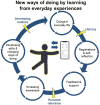Incorporating new ways of doing by learning from everyday experiences and interactions using a multifactorial mHealth app
- PMID: 36762023
- PMCID: PMC9903038
- DOI: 10.1177/20552076221149293
Incorporating new ways of doing by learning from everyday experiences and interactions using a multifactorial mHealth app
Abstract
Background: Digital health innovations can support the prevention and management of risk factors for cardiovascular diseases, such as stroke. However, little is known about people's everyday experiences of digitally augmented stroke-prevention programmes combining onsite group sessions including peers and healthcare professionals with interaction and support from a multifactorial mHealth app.
Objective: The aim of this study was to explore how people with stroke risk experienced interaction with a multifactorial mHealth app as support in the make my day stroke-prevention programme.
Methods: Repeated interviews and observations with 12 adults with moderate to high stroke risk were analysed using a constant comparative method informed by constructive grounded theory.
Results: Incorporating new ways of doing into everyday life involves a process through which participants learn from both being and doing in different environments (e.g., digital, physical and social). Digital self-monitoring combined with seemingly trivial everyday experiences played central roles in the process of increasing awareness of health and stroke risks, and providing tools to support increased self-reflection on everyday behaviours. Adoption of positive health behaviours in everyday life was supported or hindered by how easy to use and personally relevant the mHealth app was perceived to be.
Conclusions: An experience-based group programme together with a personally relevant multifactorial mHealth app can be supportive in stroke prevention to increase general health literacy and stroke risk literacy, and promote the incorporation of new ways of doing in everyday life. Routines of doing digital self-monitoring and health-promoting activities were however strongly influenced by different environments in which choices are presented. It is therefore important to explore how both self-monitoring and health-promoting activities can be incorporated into everyday routines for different individuals. Research should also explore how personally relevant mHealth can be developed and integrated into prevention practices in primary healthcare.
Keywords: blended health intervention; digital health innovations; engaging occupation; mHealth; non-communicable diseases; stroke prevention.
© The Author(s) 2023.
Conflict of interest statement
The author(s) declared no potential conflicts of interest with respect to the research, authorship, and/or publication of this article.
Figures



References
-
- Béjot Y, Bailly H, Durier Jet al. et al. Epidemiology of stroke in Europe and trends for the 21st century. Stroke Q Med Rev 2016; 45: e391–e398. - PubMed
-
- WHO. Global action plan for the prevention and control of noncommunicable diseases: 2013–2020. Geneva: WHO Press, 2013.
-
- Goldstein LB, Bushnell CD, Adams RJ, et al. Guidelines for the primary prevention of stroke: a guideline for healthcare professionals from the American Heart Association/American Stroke Association. Stroke 2011; 42: 517–584. - PubMed
LinkOut - more resources
Full Text Sources

